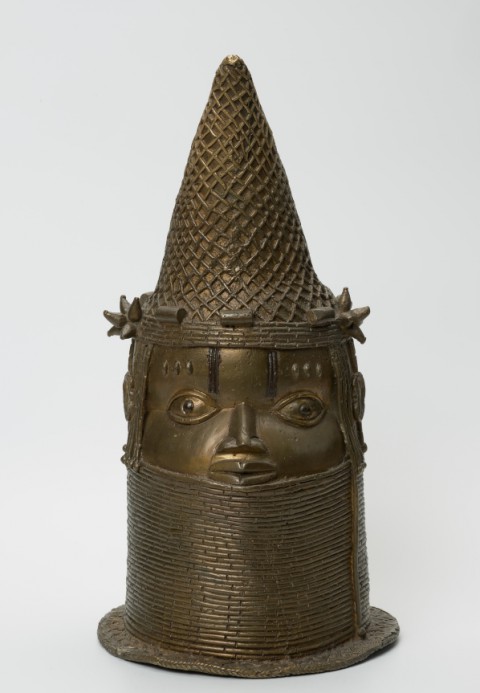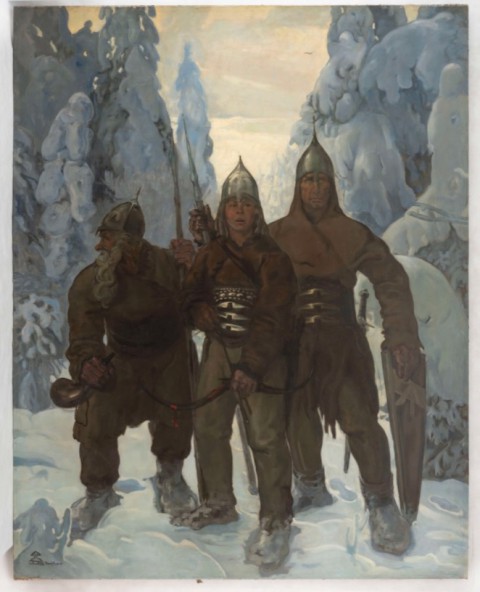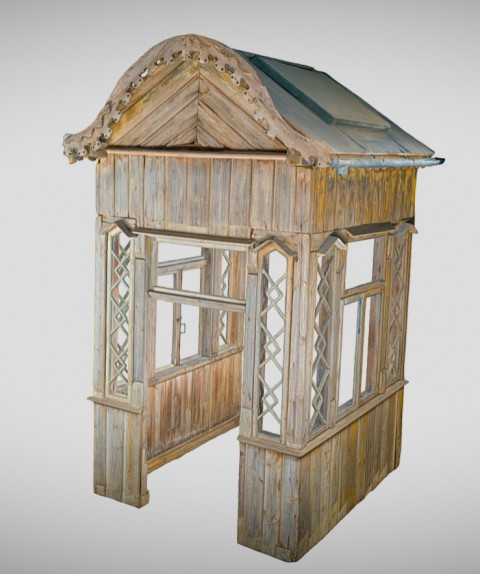Selected objects from the collection of five museums on inmuseums.pl
The main effect of the “www.muzeach” project is the creation of the inmuseums.pl website, which provides digital collections of five museums: the Museum of King Jan III's Palace at Wilanów (the project lider), the POLIN Museum of the History of Polish Jews, the National Museum in Lublin, the National Museum in Szczecin and the Castle Museum in Łańcut.
Below we present selected, particularly interesting objects from the collections of five museums.
The project “www.muzeach” is co-financed from European Funds and from the funds of the Ministry of Culture and National of the Republic of Poland. The project is implemented under the Operational Programme Digital Poland for the years 2014-2020, Priority Axis 2 “E-government and open government,” Action 2.3 “Digital availability and usefulness of public sector information,” Sub-action 2.3.2 “Digital availability of culture resources.”

- Minerva among the Muses – a virginal lid from the collection of the Museum of King Jan III's Palace at Wilanów
- The head of the Queen Mother of Benin from the collection of the National Museum in Szczecin
- “Piastuny” by Tadeusz Pruszkowski from the collection of the National Museum in Lublin
- Henryk Lubomirski as Cupid in the collection of the Castle Museum in Łańcut
- Sukkah from Szydłowiec from the collection of the POLIN Museum of the History of Polish Jews
Minerva among the Muses – a virginal lid from the collection of the Museum of King Jan III's Palace at Wilanów
The collections of the museum at Wilanów include numerous objects that are exceptional due to their artistic value and superb craftsmanship. Some of the exhibits have moving, sometimes touching stories attached to them. Together, they create a unique microcosm of history and art that makes up the Wilanów genius loci – the spirit of the place. One of such works of art is the painted lid of a virginal owned – as legend has it – by the beloved wife of King Jan III – Marysieńka, i.e. Queen Maria Kazimiera.
The story of love in the Wilanów collection
This work was purchased for his collection by Stanisław Kostka Potocki, intrigued by its history, who, together with his wife Aleksandra, opened the first museum of art in Poland in Wilanów in 1805. He immortalised the legend of the painting's origin on a piece of paper stuck to its reverse. He wrote there: "Parnassus with a Polish landscape surrounded by arabesques, a wooden board, which was the lid of the clavichord given to King Jan’s wife by the wife of Emperor Leopold, as the previous inscription said. It seems that the gift was given just before the King's departure to liberate Vienna, because the inscription included a wish that the Queen might use it to sweeten the absence of her beloved Knight using her rare musical talent, and then accompany the songs welcoming his triumphant return."
Reading the note, we learn about the love of the royal couple, about how much the founders of the museum cared for mementoes of the heroic King Jan III, and about the famous victory – the Relief of Vienna in 1683. Additionally, we can picture ways of spending time on a royal court, where people were surrounded beauty, music and literature on a daily basis.
Minerva among the Muses
It is worth taking a closer look at this work of art. The composition painted on the board is full of content, and the main theme is the allegory of music. In the centre is a scene showing Minerva, the Roman goddess of arts, crafts, wisdom, science and literature. It is surrounded by Muses, each holding a musical instrument – her attribute. In front of them, in a clearing, sheets of music together with string, wind and percussion instruments are strewn around in a picturesque disorder. They are depicted so carefully that they are a valuable source of knowledge for connoisseurs of the history of music. The main scene is framed with miniature illustrations of the myths about the messenger of the gods Mercury (Hermes) and Apollo, the god of music, poetry and art.
Antique inspirations of a unique decoration
The main theme of the painting is competition in the field of music. Around the main stage, there are systems of ribbon-tracery and grotesque ornaments, as well as representations of animals and mythical creatures. The artist (or perhaps the artists, since individual parts of the painting show stylistic differences) took the predominant themes from Ovid's Metamorphoses. A deeper interpretation can be found in Dutch treatises devoted to views on the role and meaning of music as one of the arts (e.g. in the writings of John Tinctoris, 1435 or 1436 – 1511).
Another important idea that integrates the composition, derived from the ancient aesthetics of music preached by epicureans and sceptics, is naturalis delectatio, i.e. happiness and joy that music brings.
Formerly the picture was considered to be a cover of a clavichord, but this has been questioned. Although there are faint traces of hinges on the back, comparative materials show that the instrument was indeed a virginal.
The Wilanów collection in a nutshell
The lid of the virginal is one of the historical objects that were first presented to the public at the Wilanów Palace by the founders of the local museum. It is an important sobiescianum – according to legend, it is connected with King Jan III, who had the residence built, and his wife, Queen Maria Kazimiera. In this way, Minerva among the Muses connects some of the most important exhibits of the Wilanów collection, encouraging people to learn about the history of other works of art collected in it.
The project “www.muzeach” is co-financed from European Funds and from the funds of the Ministry of Culture and National of the Republic of Poland. The project is implemented under the Operational Programme Digital Poland for the years 2014-2020, Priority Axis 2 “E-government and open government,” Action 2.3 “Digital availability and usefulness of public sector information,” Sub-action 2.3.2 “Digital availability of culture resources.”

Minerva among the Muses – a virginal lid from the collection of the Museum of King Jan III's Palace at Wilanów
The collections of the museum at Wilanów include numerous objects that are exceptional due to their artistic value and superb craftsmanship. Some of the exhibits have moving, sometimes touching stories attached to them. Together, they create a unique microcosm of history and art that makes up the Wilanów genius loci – the spirit of the place. One of such works of art is the painted lid of a virginal owned – as legend has it – by the beloved wife of King Jan III – Marysieńka, i.e. Queen Maria Kazimiera.
The story of love in the Wilanów collection
This work was purchased for his collection by Stanisław Kostka Potocki, intrigued by its history, who, together with his wife Aleksandra, opened the first museum of art in Poland in Wilanów in 1805. He immortalised the legend of the painting's origin on a piece of paper stuck to its reverse. He wrote there: "Parnassus with a Polish landscape surrounded by arabesques, a wooden board, which was the lid of the clavichord given to King Jan’s wife by the wife of Emperor Leopold, as the previous inscription said. It seems that the gift was given just before the King's departure to liberate Vienna, because the inscription included a wish that the Queen might use it to sweeten the absence of her beloved Knight using her rare musical talent, and then accompany the songs welcoming his triumphant return."
Reading the note, we learn about the love of the royal couple, about how much the founders of the museum cared for mementoes of the heroic King Jan III, and about the famous victory – the Relief of Vienna in 1683. Additionally, we can picture ways of spending time on a royal court, where people were surrounded beauty, music and literature on a daily basis.
Minerva among the Muses
It is worth taking a closer look at this work of art. The composition painted on the board is full of content, and the main theme is the allegory of music. In the centre is a scene showing Minerva, the Roman goddess of arts, crafts, wisdom, science and literature. It is surrounded by Muses, each holding a musical instrument – her attribute. In front of them, in a clearing, sheets of music together with string, wind and percussion instruments are strewn around in a picturesque disorder. They are depicted so carefully that they are a valuable source of knowledge for connoisseurs of the history of music. The main scene is framed with miniature illustrations of the myths about the messenger of the gods Mercury (Hermes) and Apollo, the god of music, poetry and art.
Antique inspirations of a unique decoration
The main theme of the painting is competition in the field of music. Around the main stage, there are systems of ribbon-tracery and grotesque ornaments, as well as representations of animals and mythical creatures. The artist (or perhaps the artists, since individual parts of the painting show stylistic differences) took the predominant themes from Ovid's Metamorphoses. A deeper interpretation can be found in Dutch treatises devoted to views on the role and meaning of music as one of the arts (e.g. in the writings of John Tinctoris, 1435 or 1436 – 1511).
Another important idea that integrates the composition, derived from the ancient aesthetics of music preached by epicureans and sceptics, is naturalis delectatio, i.e. happiness and joy that music brings.
Formerly the picture was considered to be a cover of a clavichord, but this has been questioned. Although there are faint traces of hinges on the back, comparative materials show that the instrument was indeed a virginal.
The Wilanów collection in a nutshell
The lid of the virginal is one of the historical objects that were first presented to the public at the Wilanów Palace by the founders of the local museum. It is an important sobiescianum – according to legend, it is connected with King Jan III, who had the residence built, and his wife, Queen Maria Kazimiera. In this way, Minerva among the Muses connects some of the most important exhibits of the Wilanów collection, encouraging people to learn about the history of other works of art collected in it.
The project “www.muzeach” is co-financed from European Funds and from the funds of the Ministry of Culture and National of the Republic of Poland. The project is implemented under the Operational Programme Digital Poland for the years 2014-2020, Priority Axis 2 “E-government and open government,” Action 2.3 “Digital availability and usefulness of public sector information,” Sub-action 2.3.2 “Digital availability of culture resources.”

The head of the Queen Mother of Benin from the collection of the National Museum in Szczecin
It is the only such work of art in Polish museums. Bronzes from Benin, one of the kingdoms of West Africa, which has survived to this day in the state of Edo in Nigeria, are figurines that – contrary to what the name suggests – were mostly cast or engraved in brass between the 16th and 18th centuries. They depict the figures of rulers and the most important events in the history of Benin. The figures are scattered around various European museums, the largest collection is in the British Museum in London.
Courtly art in the Kingdom of Benin
The cast of the head of the Queen Mother (Iyoba) is an example of the courtly art of the Benin Empire. Most likely it was made in the 18th or early 19th century in the late period of the kingdom. This is evidenced by the large size, weight and manner of presenting the Queen Mother devoid of any personal features. The casting is made of bronze using the lost wax method. Benin's courtly art shows a hierarchical and patrilineal society organised around the figure of the divine ruler (Oba). Initially, heads carved in wood were placed on the altars of ancestors. From the end of the 13th century, they were made of bronze, which was associated with the introduction of foundries to the court. The first casts were images of Oba.
The beginning of a new tradition
In the 16th century, the ruler of Esigie broke the tradition of killing the mother of the new king. He named his mother Iyoba Iyoba and placed her in the palace in Uselu. After the death of the Queen Mother, an altar was erected in her honour at the ruler's seat, and its main element was a bronze cast of the head. This tradition was followed by most of Esigie's successors, thus creating a new figural motif in Benin's courtly art.
A unique work of art
There is only one bronze head from Benin in Polish museum collections. It was given to the Szczecin museum by an unknown woman in 1977. She inherited this extraordinary work from her husband, who ran a scrap metal collection business in Wrocław just after the war. The figure is probably a remnant of the Berlin bronze exhibition that was hosted in Wrocław during World War II. A sudden shift in frontline cut off the exhibition's return to Berlin, and the exhibits were lost. Such a mysterious story is associated with this pearl of the African collection at the National Museum in Szczecin.
The project “www.muzeach” is co-financed from European Funds and from the funds of the Ministry of Culture and National of the Republic of Poland. The project is implemented under the Operational Programme Digital Poland for the years 2014-2020, Priority Axis 2 “E-government and open government,” Action 2.3 “Digital availability and usefulness of public sector information,” Sub-action 2.3.2 “Digital availability of culture resources.”

“Piastuny” by Tadeusz Pruszkowski from the collection of the National Museum in Lublin
Three warriors march through the thicket of tall trees covered with a thick layer of snow. Dark brown silhouettes stand out strongly from the white of the snow curtain and the frosty sky glittering above them. Silver helmets and buckles of ornate belts glisten in the twilight. They tread carefully. The bearded old man wielding the hunting horn, looks carefully from side to side and listens. Next to it is a tall companion with a sword at his side, a spear in one hand, and a shield in the other hand. The youngest warrior, still a boy, goes ahead, holding a bow ready to shoot in front of him. This is how we can describe the "plot" of Tadeusz Pruszkowski's painting Piastuny from 1917, monumental in its composition and expression. The content and meaning of the scene depicted are puzzling. Who are its title characters? ‘Piastuny’ (guardians) were formerly defined as high court officials entrusted with the upbringing of royal or princely sons. The two older men shown in the picture are such guardians and teachers of the boy. They are making him accustomed to the dangers of hunting.
From a Slavic warrior to a legionary soldier
The work has several complementary meanings, which should be associated with the uprising, when the fate of Poland was at stake and regaining sovereignty was becoming increasingly probable. The mood was reflected in the art of that time. Tadeusz Pruszkowski, a young painter and a legionnaire who returned from the front, painted several works related in terms of content and form. In 1916, he presented The Legend of Sleeping Knights, followed by Piastuny the year after. Their subjects were motifs and figures from the early history of Poland, intertwined with legendary tales about the beginning of the nation and its founders. The warriors-guardians are a symbolic personification of Slavic ancestors – the Piasts. The highlighted details of the outfit, i.e. elaborate belts, bring to mind highlander costumes. This in turn alludes to the then popular legend of the royal army sleeping near the Giewont, perfectly reflecting the mood of national expectations and aspirations.
Pruszkowski – a lover of art and life
Pruszkowski's two early canvases (from which only Piastuny has survived to this day) are an exception to his oeuvre. He painted mostly portraits, sometimes landscapes and still lifes. The painter drew inspiration from the art of the Renaissance and Baroque masters, distancing himself from avant-garde concepts. The author of the works, enchanting with their freedom, luminous colour and expression, is remembered equally as an animator and a colourful figure of the interwar cultural life. Pruszkowski was a cheerful, big-hearted and generous man with vivid imagination, constantly curious about the world. He was not only a painter, but also a teacher, traveller, rally driver, pilot, violin virtuoso, and even a film director. In 1926, together with his students, he made a film with the surreal title: The Happy Hangman, or California in Poland. He dealt with art matters as a decision-maker at the Institute of Art Propaganda. He was an initiator of various artistic projects: competitions, exhibitions, government orders; and a founder of many artistic groups, publisher and critic. It should be remembered that in the 1920s Pruszkowski artistically revived and made famous the town of Kazimierz Dolny, located near Lublin. He lived there in a fancy villa with a round tower and ran a paint shop, which was the cradle of the Brotherhood of St. Luke. Every year he organized painting workshops in the town. Among his many activities, the work of a teacher was the most important, which is indirectly reflected in Piastuny. His inborn predispositions and kindness combined with the commitment to create a Polish painting school resulted in training a large group of students. Those of them who escaped death during World War II went down in the history of Polish art. The master was not allowed to enjoy their achievements as he was shot by German soldiers in 1942.
Bożena Kasperowicz
The project “www.muzeach” is co-financed from European Funds and from the funds of the Ministry of Culture and National of the Republic of Poland. The project is implemented under the Operational Programme Digital Poland for the years 2014-2020, Priority Axis 2 “E-government and open government,” Action 2.3 “Digital availability and usefulness of public sector information,” Sub-action 2.3.2 “Digital availability of culture resources.”

Henryk Lubomirski as Cupid in the collection of the Castle Museum in Łańcut
Henryk Lubomirski was born in 1777 in Rivne in Volhynia. He was the son of Józef, the castellan of Kiev, a distant relative of the husband of Princess Izabela Lubomirska née Czartoryska, and Ludwika née Sosnowska. When Henryk was about six years old, he went to be raised by Princess Izabela Lubomirska née Czartoryska, the owner of the Castle in Łańcut.
From Volhynia to Łańcut
In the collection of the Library of the Castle Museum in Łańcut there is a manuscript of Henryk's granddaughter, Maria Tyszkiewiczowa née Lubomirska, and in it a family message: "So it happened that when she was in Rivne with Prince Józef Lubomirski [...], Princess Ludwika came out during the ball to the parlour and sitting on the couch, she fed her lovely little son and put him on that couch afterward to sleep alone while she returned to the ballroom to dance. Then, having forgotten about him, she went to sleep. The next morning, the Princess Izabela, was leaving Rivne and, seeing the wonderful child alone on the couch, she could not help herself but grabbed the child, laid it in a fur-lined basket and went with him to Łańcut. During the journey, she sent a message to his parents telling them not to worry and asking them to agreed to let her take their son, whom she would look after like a mother. The parents agreed and Prince Henryk grew up with his foster mother and was her joy”.
Henryk's childhood
Thanks to the care of Princess Izabela Lubomirska née Czartoryska, Henryk received a good education. He also took harp lessons and learned to dance. He lived in residences in Łańcut and Vienna. He also accompanied his foster mother on her travels. In Rome, at the request of the Princess, Henryk was portrayed by the painter Angelika Kauffmann. The sculptor Antonio Canova (1757–1822) made a marble statue of the adoptive son of Princess Izabela in the years 1786–1788. This most prominent representative of Italian neoclassicism presented the boy as Cupid, the mythological god of love.
Remarkable sculpture
The statue shows a naked young man with a bow in his hand, leaning against a tree trunk to which a quiver of arrows is tied. The model's head – the copy of the original – was placed on the body of a boy a few years older than Henryk, showing him not as a child, but as a teenager.
The statue of Henryk Lubomirski as Cupid can be seen on the first floor of the Łańcut Castle, in the Column Hall. The interior was designed by Szymon Bogumił Zug and Jan Chrystian Kamsetzer to resemble an ancient temple. The sculpture located on the axis of the room is surrounded by Ionic columns, which increase similarity to an ancient temple. Behind the sculpture on the walls, on the right and left, there is a Chinese fabric from the turn of the 17th and18th centuries with a pattern telling the story of an unusual bird Feng (Phoenix), to which other birds pay tribute.
The bond between Henryk Lubomirski and his foster mother was very durable.
The Princess was very generous to Henryk: In 1799 she bought him the city of Przeworsk and also bequeathed to him the palace in Vienna at Mölker Bastei and part of the collection in Łańcut.
JGCh
The project “www.muzeach” is co-financed from European Funds and from the funds of the Ministry of Culture and National of the Republic of Poland. The project is implemented under the Operational Programme Digital Poland for the years 2014-2020, Priority Axis 2 “E-government and open government,” Action 2.3 “Digital availability and usefulness of public sector information,” Sub-action 2.3.2 “Digital availability of culture resources.”

Sukkah from Szydłowiec from the collection of the POLIN Museum of the History of Polish Jews
In the 1920s, Nuta Ajzenberg, the owner of a tannery in Szydłowiec, commissioned the construction of a sukkah, i.e. a building erected by Jews for the Sukkot holiday, next to his house. The sukkah survived in Szydłowiec for several dozen years, and the last owners of the house donated it to the collection of the POLIN Museum of the History of Polish Jews.
Genesis of the sukkah and its interior
The sukkah is a temporary building erected by Jews for the festival of Sukkot (Feast of Booths, in Poland formerly known as the Feast of the Sukkahs), which commemorates the exodus of Jews from Egypt, their journey through the desert to Canaan and the protection of divine providence. In memory of these events, during the seven days of Sukkot, holiday meals are eaten in sukkahs (for more information, see Sukkot | Virtual Shtetl, accessed on 10.12.2021). Before World War II, sukkahs were built within houses, on balconies or porches, as well as in backyards. They were a natural element of the cultural landscape of Poland.
The interiors of the walls of the Sukkah from Szydłowiec are covered with colourful polychrome referring to the holiday symbolism (etrog citrus fruit, palm, myrtle and willow), in the panel above the entrance opening there is a star of David. The roof of the sukkah can be opened – it is also one of the requirements of the festive liturgy.
According to the chief curator of the POLIN collection, Renata Piątkowska, Ph.D., the sukkah from Szydłowiec is an important material trace of Jewish culture. This unusual object was in danger of being destroyed. Thanks to the involvement of many people and institutions (donors: Monica and Norbert Bekiel, the association Jewish Historical Institute in Poland, the Radom Open Air Museum and the POLIN Museum of the History of Polish Jews), it was possible to save this unique object and show it to the public.
Sukkah’s recent history
The sukkah has been in the collection of the POLIN Museum since 2008, but due to the ongoing construction, it could not be exhibited. At that time, cooperation was established with the Radom Open Air Museum, which agreed to look after it. Thanks to the help of a team of conservators from the museum in Radom, the sukkah was inventoried and dismantled. For the next six years, it was kept in the museum’s shelter. In June 2014, the return of the sukkah to the POLIN Museum of the History of Polish Jews began. Thorough work on preserving its original appearance took three months. Then it was deposited at the State Ethnographic Museum. Currently, it can be admired at the "Celebration Time" exhibition (until 30 September 2023)
Sukkah in the digital collection
Those who cannot visit the State Ethnographic Museum or would like to see the sukkah again, can do it online at inmuseums.pl. The object was digitised with the photogrammetric technique with an accuracy of one millimetre. The measurement data was used to create a three-dimensional model that recreates the object in three dimensions. This form of digitisation allows for the most accurate image of the object and provides insight into its detailed geometry, texture, colour and state of preservation. The developed documentation will be used by professionals and specialists in the field of conservation, art history, history, architecture, as well as photogrammetry, not only as a 3D metric inventory, but also as a basis for further studies and analyses. On the other hand, the public can get to know one of the most important elements of the architectural heritage of Polish Jews. The digitisation was carried out in cooperation with specialists from the Museum of King Jan III's Palace at Wilanów and the State Ethnographic Museum.
The project “www.muzeach” is co-financed from European Funds and from the funds of the Ministry of Culture and National of the Republic of Poland. The project is implemented under the Operational Programme Digital Poland for the years 2014-2020, Priority Axis 2 “E-government and open government,” Action 2.3 “Digital availability and usefulness of public sector information,” Sub-action 2.3.2 “Digital availability of culture resources.”




















